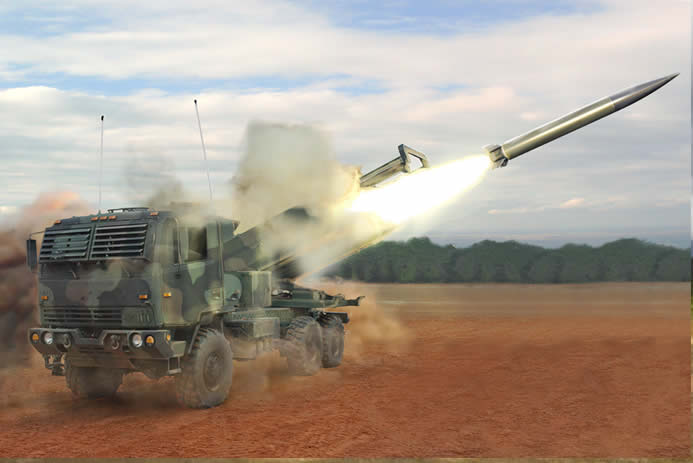
Has U.S. land warfighting capability been compromised by advances by potential adversaries in long-range artillery capabilities? Michael Jacobson and Robert H. Scales argue that this is the case in an article on War on the Rocks.
While the U.S. Army has made major advances by incorporating precision into artillery, the ability and opportunity to employ precision are premised on a world of low-intensity conflict. In high-intensity conflict defined by combined-arms maneuver, the employment of artillery based on a precise point on the ground becomes a much more difficult proposition, especially when the enemy commands large formations of moving, armored vehicles, as Russia does. The U.S. joint force has recognized this dilemma and compensates for it by employing superior air forces and deep-strike fires. But Russia has undertaken a comprehensive upgrade of not just its military technology but its doctrine. We should not be surprised that Russia’s goal in this endeavor is to offset U.S. advantages in air superiority and double-down on its traditional advantages in artillery and rocket mass, range, and destructive power.
Jacobson and Scales provide a list of relatively quick fixes they assert would restore U.S. superiority in long-range fires: change policy on the use of cluster munitions; upgrade the U.S. self-propelled howitzer inventory from short-barreled 39 caliber guns to long-barreled 52 calibers and incorporate improved propellants and rocket assistance to double their existing range; reevaluate restrictions on the forthcoming Long Range Precision Fires rocket system in light of Russian attitudes toward the Intermediate Range Nuclear Forces treaty; and rebuild divisional and field artillery units atrophied by a decade of counterinsurgency warfare.
Their assessment echoes similar comments made earlier this year by Lieutenant General H. R. McMaster, director of the U.S. Army’s Capabilities Integration Center. Another option for countering enemy fire artillery capabilities, McMaster suggested, was the employment of “cross-domain fires.” As he explained, “When an Army fires unit arrives somewhere, it should be able to do surface-to-air, surface-to-surface, and shore-to-ship capabilities.
The notion of land-based fire elements engaging more than just other land or counter-air targets has given rise to a concept being called “multi-domain battle.” It’s proponents, Dr. Albert Palazzo of the Australian Army’s War Research Centre, and Lieutenant Colonel David P. McLain III, Chief, Integration and Operations Branch in the Joint and Army Concepts Division of the Army Capabilities Integration Center, argue (also at War on the Rocks) that
While Western forces have embraced jointness, traditional boundaries between land, sea, and air have still defined which service and which capability is tasked with a given mission. Multi-domain battle breaks down the traditional environmental boundaries between domains that have previously limited who does what where. The theater of operations, in this view, is a unitary whole. The most useful capability needs to get the mission no matter what domain it technically comes from. Newly emerging technologies will enable the land force to operate in ways that, in the past, have been limited by the boundaries of its domain. These technologies will give the land force the ability to dominate not just the land but also project power into and across the other domains.
Palazzo and McClain contend that future land warfare forces
…must be designed, equipped, and trained to gain and maintain advantage across all domains and to understand and respond to the requirements of the future operating environment… Multi-domain battle will create options and opportunities for the joint force, while imposing multiple dilemmas on the adversary. Through land-to-sea, land-to-air, land-to-land, land-to-space, and land-to-cyberspace fires and effects, land forces can deter, deny, and defeat the adversary. This will allow the joint commander to seize, retain, and exploit the initiative.
As an example of their concept, Palazzo and McClain cite a combined, joint operation from the Pacific Theater in World War II:
Just after dawn on September 4, 1943, Australian soldiers of the 9th Division came ashore near Lae, Papua in the Australian Army’s first major amphibious operation since Gallipoli. Supporting them were U.S. naval forces from VII Amphibious Force. The next day, the 503rd U.S. Parachute Regiment seized the airfield at Nadzab to the West of Lae, which allowed the follow-on landing of the 7th Australian Division. The Japanese defenders offered some resistance on the land, token resistance in the air, and no resistance at sea. Terrain was the main obstacle to Lae’s capture.
From the beginning, the allied plan for Lae was a joint one. The allies were able to get their forces across the approaches to the enemy’s position, establish secure points of entry, build up strength, and defeat the enemy because they dominated the three domains of war relevant at the time — land, sea, and air.
The concept of multi-domain warfare seems like a logical conceptualization for integrating land-based weapons of increased range and effect into the sorts of near-term future conflicts envisioned by U.S. policy-makers and defense analysts. It comports fairly seamlessly with the precepts of the Third Offset Strategy.
However, as has been observed with the Third Offset Strategy, this raises questions about the role of long-range fires in conflicts that do not involve near-peer adversaries, such as counterinsurgencies. Is an emphasis on technological determinism reducing the capabilities of land combat units to just what they shoot? Is the ability to take and hold ground an anachronism in anti-access/area-denial environments? Do long-range fires obviate the relationship between fire and maneuver in modern combat tactics? If even infantry squads are equipped with stand-off weapons, what is the future of close quarters combat?
